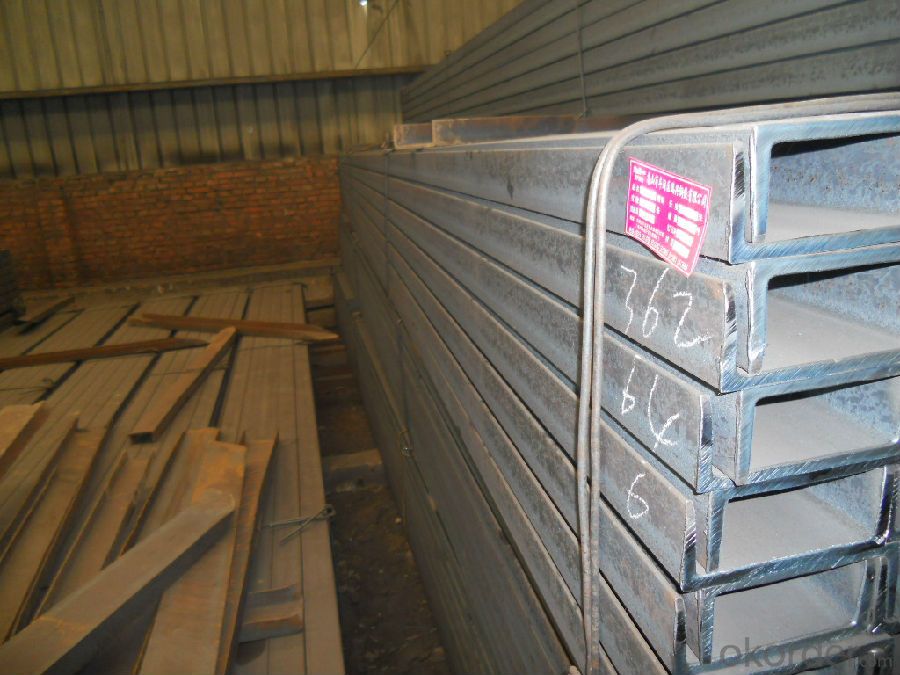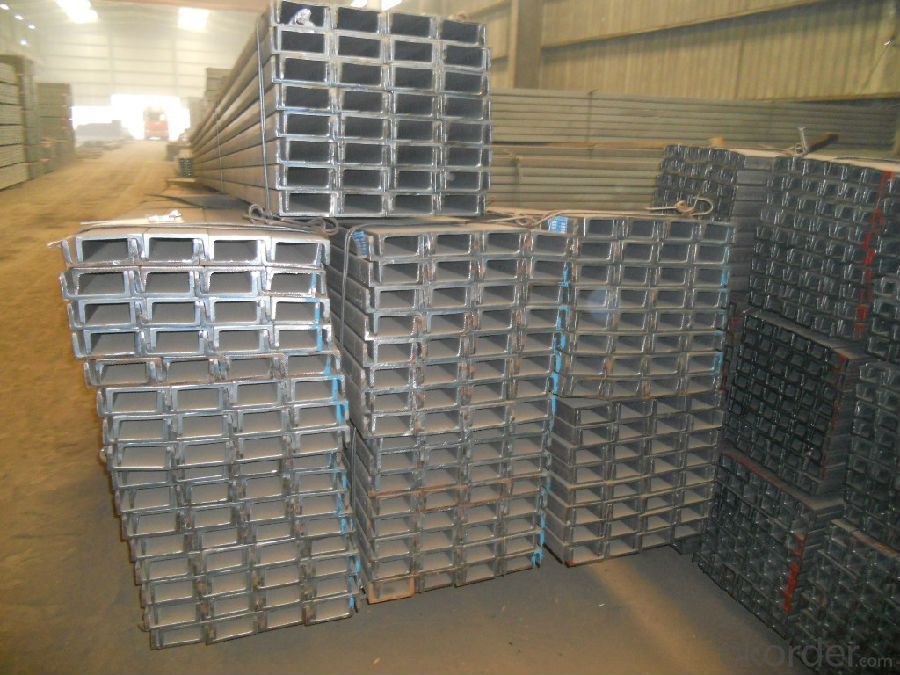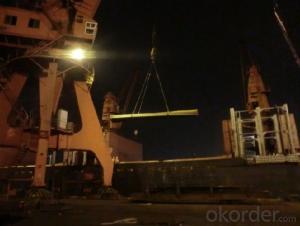Structure U Channel Steel high quality
- Loading Port:
- Tianjin
- Payment Terms:
- TT OR LC
- Min Order Qty:
- 25 m.t
- Supply Capability:
- 20000 m.t/month
OKorder Service Pledge
OKorder Financial Service
You Might Also Like
Product Description:
OKorder is offering Structure U Channel Steel high quality prices with worldwide shipping. Our supplier is a world-class manufacturer of steel, with our products utilized the world over. OKorder annually supplies products to European, North American and Asian markets. We provide quotations within 24 hours of receiving an inquiry and guarantee competitive prices.
Product Applications:
Structure U Channel Steel high quality are ideal for structural applications and are widely used in the construction of buildings and bridges, and the manufacturing, petrochemical, and transportation industries.
Product Advantages:
OKorder's Structure U Channel Steel high quality durable, strong, and resist corrosion.
Main Product Features:
· Premium quality
· Prompt delivery & seaworthy packing (30 days after receiving deposit)
· Corrosion resistance
· Can be recycled and reused
· Mill test certification
· Professional Service
· Competitive pricing
Product Specifications:
Specifications of Steel U Channel:
Standard Applied: GB Standard, EN Standard(UPN), JIS Standard
Sizes: 50mm to 300mm
Material Grade: Q235B, Q345B, S235JR, SS400, ASTM A36
As shown in the figure:
JIS U CHANNEL | Standard h | Sectional b | Dimension s | t | Mass: Kg/m |
(mm) | (mm) | (mm) | (mm) | ||
50x25 | 50 | 25 | 3.0 | 6.00 | 2.37 |
75X40 | 75 | 40 | 3.8 | 7.00 | 5.30 |
75X40 | 75 | 40 | 4.0 | 7.00 | 5.60 |
75X40 | 75 | 40 | 4.5 | 7.00 | 5.85 |
75X40 | 75 | 40 | 5.0 | 7.00 | 6.92 |
100X50 | 100 | 50 | 3.8 | 6.00 | 7.30 |
100X50 | 100 | 50 | 4.2 | 6.00 | 8.03 |
100X50 | 100 | 50 | 4.5 | 7.50 | 8.97 |
100X50 | 100 | 50 | 5.0 | 7.50 | 9.36 |
125X65 | 125 | 65 | 5.2 | 6.80 | 11.66 |
125X65 | 125 | 65 | 5.3 | 6.80 | 12.17 |
125X65 | 125 | 65 | 5.5 | 8.00 | 12.91 |
125X65 | 125 | 65 | 6.0 | 8.00 | 13.40 |
150x75 | 150 | 75 | 5.5 | 7.30 | 14.66 |
150x75 | 150 | 75 | 5.7 | 10.00 | 16.71 |
150x75 | 150 | 75 | 6.0 | 10.00 | 17.90 |
150x75 | 150 | 75 | 6.5 | 10.00 | 18.60 |
Note: We are able to supply other dimensions and sizes, which depends on the customer's requirements for the quantity.
Chemical Composition of Q235B Steel U Channel:
Alloy No | Grade | Element(%) | ||||
C | Mn | S | P | Si | ||
Q235 | B | 0.12-0.20 | 0.3-0.7 | ≦0.045 | ≦0.045 | ≦0.3 |
FAQ:
Q1: Why buy Materials & Equipment from OKorder.com?
A1: All products offered byOKorder.com are carefully selected from China's most reliable manufacturing enterprises. Through its ISO certifications, OKorder.com adheres to the highest standards and a commitment to supply chain safety and customer satisfaction.
Q2: What makes stainless steel stainless?
A2: Stainless steel must contain at least 10.5 % chromium. It is this element that reacts with the oxygen in the air to form a complex chrome-oxide surface layer that is invisible but strong enough to prevent further oxygen from "staining" (rusting) the surface. Higher levels of chromium and the addition of other alloying elements such as nickel and molybdenum enhance this surface layer and improve the corrosion resistance of the stainless material.
Q3: Can stainless steel rust?
A3: Stainless does not "rust" as you think of regular steel rusting with a red oxide on the surface that flakes off. If you see red rust it is probably due to some iron particles that have contaminated the surface of the stainless steel and it is these iron particles that are rusting. Look at the source of the rusting and see if you can remove it from the surface.
Images:


- Q:Can steel channels be used in food processing facilities?
- Yes, steel channels can be used in food processing facilities. Steel channels are commonly used in the construction of industrial facilities due to their durability, strength, and resistance to corrosion. In food processing facilities, where hygiene and cleanliness are crucial, stainless steel channels are often preferred. Stainless steel is resistant to rust and can withstand exposure to water, chemicals, and high temperatures without corroding or contaminating the food products. These channels can be used for various purposes in food processing facilities, including supporting equipment, creating partitions, and forming structural elements. Additionally, stainless steel channels are easy to clean and maintain, making them suitable for use in environments that require strict cleanliness and sanitation standards.
- Q:Use two long five meters of 10# channel steel load-bearing frame, the maximum load is?
- 8 channel steel and 40*60 square steel tube, which is good in bending strength?
- Q:I want to know what kind of steel is this type of steel, such as channel steel and die steel?
- Channel steel is Q235 and die steel is alloy steel
- Q:How do steel channels compare to other building materials?
- Steel channels have several advantages over other building materials. Firstly, steel channels have a high strength-to-weight ratio, making them an ideal choice for structural support applications. They can withstand heavy loads and provide excellent stability and durability. Additionally, steel channels are highly resistant to fire, corrosion, and pests, which makes them a reliable and long-lasting option for construction projects. They do not rot, warp, or require frequent maintenance, making them a cost-effective choice in the long run. Moreover, steel channels offer versatility in design and construction. They can be easily customized and fabricated to meet specific project requirements. Steel channels also provide flexibility during the construction process, as they can be easily modified or reinforced if needed. Furthermore, steel channels are environmentally friendly. They can be recycled and reused without losing their properties, making them a sustainable choice for construction projects. Steel production also requires less energy compared to other building materials, reducing the carbon footprint. Lastly, steel channels offer cost-effectiveness. While the initial cost may be higher than some other materials, the long-term benefits outweigh the investment. They require minimal maintenance and have a longer lifespan, resulting in lower maintenance and replacement costs over time. Overall, steel channels are a superior choice compared to other building materials due to their strength, durability, resistance to fire and corrosion, versatility, sustainability, and cost-effectiveness.
- Q:Can steel channels be used for stair stringers in commercial buildings?
- Yes, steel channels can be used as stair stringers in commercial buildings. Steel channels are often preferred for their strength, durability, and load-bearing capabilities, making them suitable for supporting staircases in high-traffic areas such as commercial buildings. Additionally, steel channels can be easily fabricated and installed, providing a reliable and long-lasting solution for stair stringers in these settings.
- Q:What are the different design considerations for steel channels in high-rise buildings?
- There are several important design considerations when it comes to steel channels in high-rise buildings. These considerations include structural integrity, load-bearing capacity, fire resistance, acoustics, and sustainability. Firstly, structural integrity is crucial in high-rise buildings as they are subjected to various loads such as dead loads, live loads, wind loads, and seismic loads. Steel channels need to be designed to withstand these loads and provide sufficient strength and stability to the structure. This involves selecting the appropriate channel size, thickness, and configuration to ensure the structural integrity of the building. Load-bearing capacity is another important consideration. Steel channels must be able to support the weight of the building and its contents. The load-bearing capacity is determined by factors such as the material properties of the steel, the size and shape of the channels, and the connection details. Proper design and analysis are essential to ensure that the steel channels can safely carry the required loads without any risk of failure. Fire resistance is a critical consideration in high-rise buildings. Steel channels need to be designed to withstand high temperatures and prevent the spread of fire. This can be achieved through the use of fire-resistant coatings or by incorporating fire-resistant materials into the design. Adequate fire protection measures, such as fireproofing or fire-rated enclosures, should also be considered to enhance the overall fire safety of the building. Acoustics is another important aspect to consider, especially in high-rise buildings where noise transmission can be a significant issue. Steel channels should be designed to minimize sound transmission and provide appropriate acoustic insulation. This can be achieved through the use of sound-absorbing materials, soundproofing techniques, or by incorporating specialized channel designs that reduce noise transmission. Lastly, sustainability is becoming an increasingly important consideration in building design. Steel channels can contribute to sustainability by using recycled materials, minimizing waste during fabrication, and providing long-term durability. Additionally, the design of steel channels should consider energy efficiency and the potential for future adaptability or reuse. In conclusion, the design considerations for steel channels in high-rise buildings include structural integrity, load-bearing capacity, fire resistance, acoustics, and sustainability. By carefully considering these factors, engineers can ensure the safety, functionality, and long-term performance of steel channels in high-rise construction projects.
- Q:Channel steel is a strip of steel with a cross section.
- Channel 50 is [50]
- Q:What are the guidelines for steel channel installations in seismic zones?
- The guidelines for steel channel installations in seismic zones typically include ensuring that the channels are properly sized and designed to withstand seismic loads, using appropriate fasteners and connections to secure the channels to the structure, and following local building codes and regulations related to seismic design. It is also important to consider factors such as the type of seismic zone, the expected level of seismic activity, and any specific requirements or recommendations from structural engineers or seismic experts.
- Q:Can steel channels be used for shelving systems?
- Yes, steel channels can be used for shelving systems. Steel channels are strong and durable, making them suitable for supporting heavy loads. They can be easily attached to walls or other structures to create a stable and sturdy shelving system. Additionally, steel channels come in various sizes and lengths, allowing for customization to fit different storage needs. Overall, steel channels are a popular choice for shelving systems in warehouses, garages, and other industrial settings due to their strength and versatility.
- Q:Can steel channels be used for noise reduction purposes?
- Steel channels, also referred to as acoustic metal channels, have the ability to serve noise reduction purposes. These channels are commonly utilized as part of soundproofing systems in buildings and structures. Their primary function is to absorb and dampen noise vibrations, thereby minimizing sound transmission. In terms of composition, steel channels are crafted from top-notch steel and possess unique dimensions and shapes that enhance their acoustic properties. Installations of these channels typically occur between walls, floors, or ceilings, creating a barrier that effectively blocks sound passage. The effectiveness of steel channels in noise reduction is contingent upon several factors, including the channel's thickness and material, the noise type and frequency, and the overall soundproofing setup employed. When properly installed in conjunction with other soundproofing materials like insulation, acoustic panels, or mass-loaded vinyl, the utilization of steel channels can significantly diminish the ingress or egress of noise within a space. It is worth mentioning, however, that although steel channels can be efficacious in reducing noise, they may not completely eradicate all sounds. Certain low-frequency or high-intensity noises may still penetrate the soundproofing system. Consequently, it is imperative to seek guidance from professionals or acoustic engineers to identify the most suitable soundproofing solutions based on specific requirements and noise levels.
1. Manufacturer Overview |
|
|---|---|
| Location | |
| Year Established | |
| Annual Output Value | |
| Main Markets | |
| Company Certifications | |
2. Manufacturer Certificates |
|
|---|---|
| a) Certification Name | |
| Range | |
| Reference | |
| Validity Period | |
3. Manufacturer Capability |
|
|---|---|
| a)Trade Capacity | |
| Nearest Port | |
| Export Percentage | |
| No.of Employees in Trade Department | |
| Language Spoken: | |
| b)Factory Information | |
| Factory Size: | |
| No. of Production Lines | |
| Contract Manufacturing | |
| Product Price Range | |
Send your message to us
Structure U Channel Steel high quality
- Loading Port:
- Tianjin
- Payment Terms:
- TT OR LC
- Min Order Qty:
- 25 m.t
- Supply Capability:
- 20000 m.t/month
OKorder Service Pledge
OKorder Financial Service
Similar products
New products
Hot products
Related keywords




























